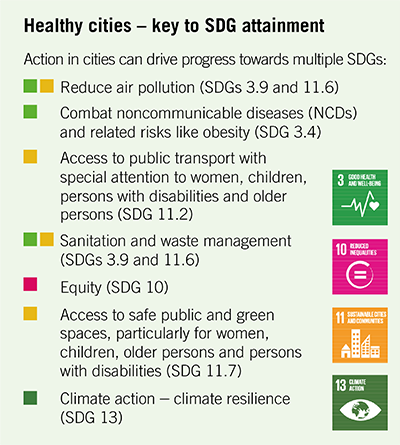Strategies
Health is a precondition for and an outcome of sustainable development, particularly in cities. The Agenda for Sustainable Development Goals (SDGs) acknowledges the importance of health in the context of “ensuring healthy lives and promote well-being for all” (SDG3), “reducing inequality within and among countries (SDG10),” “making cities inclusive, safe, resilient and sustainable” (SDG11) and “taking urgent action to combat climate change and its impacts (SDG13).”
To achieve these and all SDGs, cooperation between different stakeholders and institutions is urgently needed – not only to make the best use of finite resources, but to capitalize on synergies and ensure policy coherence to achieve systemic change. Acknowledging health as a central component of urban planning and governance cities will be better positioned to deliver on this vision of sustainable urban development for all.
Strategies to create and maintain healthy urban environments have a short- and long-term effect on people’s health and well-being. Well-designed healthy urban environments strategies can reduce air pollution and noise, and create spaces that promote active mobility, physical activity, social interactions, recreation and relaxation, and safe conditions for living.
Effective strategies for sustainable, healthy urban environments involve:
- Promotion of quality, accessible and equitable green and blue spaces in urban areas, making sure that:
- these natural spaces will be distributed across the whole urban area, to benefit all the population and not only some dwellers;
- green and blue spaces are connected, so it promotes the use of these spaces for active mobility;
- characteristics of these natural spaces are diverse to promote different uses (e.g. physical activity, relaxation, social interactions) and engage different groups of the population (e.g. adults, children, elderly, women, etc.).
- Air pollution and noise reduction through:
- more investments in, and prioritization of, quality, efficient and safe public transport;
- more investment in, and prioritization of, areas and routes that facilitate quality, efficient and safe active mobility;
- reduction of motorised traffic and speed limit;
- promotion of low-noise road surfacing;
- incorporation of adequate vegetation in urban areas;
- adoption of cleaner vehicular and fuel technologies;
- adoption of cleaner and efficient heating and cooking technologies.
- Accessible and affordable healthy food.
- Adequate sanitation and waste management.
- Safe drinking-water for all.
- Promotion of compact cities (or medium-density houses) which offer a variety of services (e.g. shops, schools, recreation areas, work) easily accessible for everybody.
- Improved building materials and insulation.
- Reduction of heat associated with human activities (e.g. heating) to reduce the urban heat island effect.
- Actions to reduce or mitigate the effects of climate change.
- Reduction of crime, violence, and insecurity.
- Promotion of community engagement, social cohesion and sense of community-belonging.

